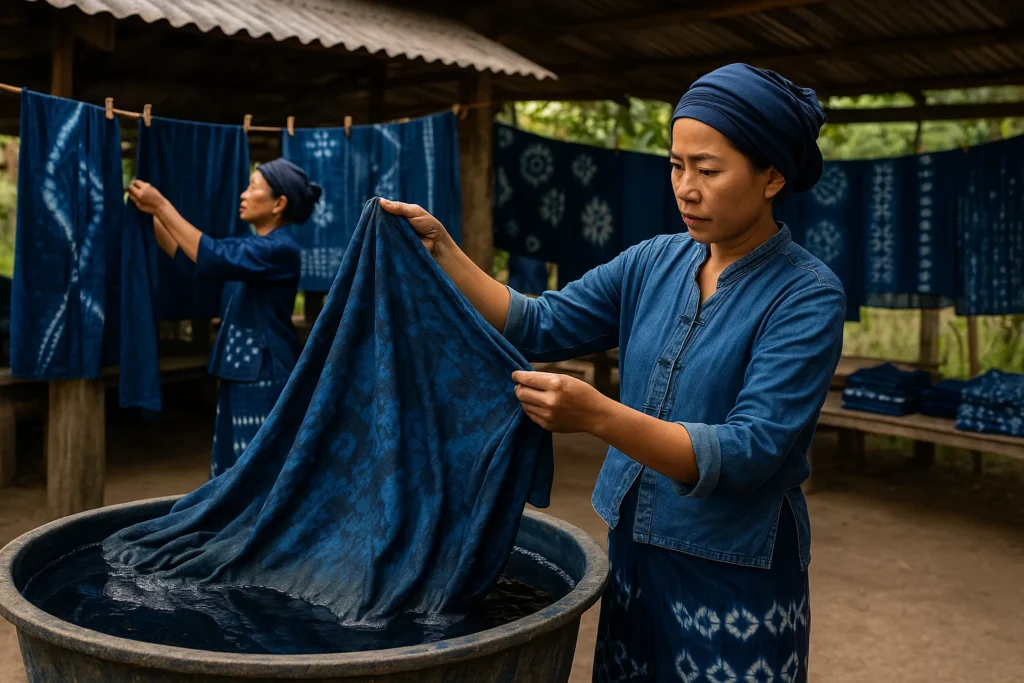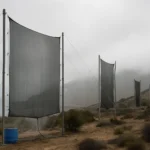Introduction: The Blue Thread of Tradition
In the verdant embrace of Northern Thailand, specifically within the serene, undulating landscapes and tranquil villages of Sakon Nakhon, an ancient whisper is not merely transforming into a vibrant song, but echoing as a powerful symphony. The captivating, profound blues of natural indigo dye, once teetering precariously on the precipice of oblivion—a mere ghost of a memory—are now experiencing a magnificent rebirth, painstakingly coaxed back to life by a dedicated and passionate generation of artisans. This narrative, however, extends far beyond the tactile realm of fabric and thread; it is a profound and moving saga woven with threads of cultural pride, steadfast environmental stewardship, and a burgeoning global recognition that celebrates authenticity and heritage.
For countless centuries, the skilled hands of Thai artisans, guided by ancestral wisdom, meticulously transformed the humble indigofera plant into breathtaking textiles of unparalleled beauty. They achieved this feat by employing time-honored organic fermentation techniques, a secret passed down through generations. Yet, with the relentless, unyielding advance of synthetic dyes and the insatiable, dizzying pace of fast fashion, this invaluable tradition, a cornerstone of their identity, faced an existential threat, teetering on the brink of complete extinction. Today, however, a profound and heartwarming resurgence is underway, a testament to human resilience and reverence for the past. Thanks to the tireless, community-driven efforts of local cooperatives, the visionary insights of eco-conscious designers, and a rekindled, heartfelt appreciation for authentic, handmade crafts, indigo dyeing is not merely surviving—it’s flourishing with newfound vigor, making an indelible mark on the world stage, one exquisite, naturally dyed thread at a time.
1. The Ancient Art of Thai Indigo Dyeing: A Legacy Steeped in Blue
From Plant to Pigment: A Labor of Love and Legacy
The creation of indigo dye is a testament to unwavering patience, profound skill, and an intimate understanding of nature’s rhythms—it is anything but a simple undertaking. This intricate and almost mystical process commences with the careful, respectful harvesting of indigofera tinctoria, a verdant, leafy plant that thrives robustly within Thailand’s warm, humid embrace. Once gathered, these precious leaves embark on their transformative journey: they are meticulously submerged in water and allowed to ferment over several days. This slow, magical transformation gradually yields a rich, deep blue pigment, the very soul of the dye. Unlike its synthetic counterparts, which offer instant gratification, natural indigo demands not just time but also a refined patience and unparalleled skill, a profound understanding of subtle cues. Each precious batch of indigo dye requires weeks of dedicated preparation, a true labor of love that honors the legacy of those who came before. It is a process where the artisan is not just a maker, but a custodian of ancient wisdom.
The Alchemy of Fermentation: Nature’s Miraculous Transformation
The fermented liquid, now a potent, mystical elixir, is then meticulously stirred. This seemingly simple action is, in fact, a crucial step: as oxygen slowly intermingles with the solution, it awakens the dormant dye, initiating a chemical reaction that is nothing short of miraculous. When fabric is carefully, almost reverently, dipped into this living brew, it emerges initially green, almost as if holding its breath, anticipating its metamorphosis. Then, as if by pure magic, upon exposure to the open air, it slowly, exquisitely, begins its breathtaking transformation, deepening from a nascent green to a mesmerizing, profound deep blue. This alchemical process, refined and perfected over countless generations, has been passed down with a sense of sacred reverence, with each artisan subtly imbuing the craft with their unique touch, their personal spirit, and a lifetime of accumulated wisdom. It’s a harmonious dance between nature’s abundant bounty and human ingenuity, resulting in a color that speaks volumes, echoing tales of the earth and sky. The depth of the blue, the subtle variations in hue—these are not imperfections but rather the fingerprints of authenticity, telling a story that mass-produced dyes can never replicate.
2. The Decline and Near Extinction of a Cherished Craft: A Fading Horizon
The Shadow of Synthetic Dyes: A Race Against Time
As the 20th century drew to its close, a formidable wave of inexpensive chemical dyes crashed upon the global market, flooding it with vibrant, yet soulless, colors. Mass-produced fabrics, churned out with unparalleled speed and at significantly lower costs, began to mercilessly eclipse the painstaking artistry and profound heritage of traditional indigo dyeing. This rapid, almost brutal shift pushed the ancient craft to the very edge of survival, leaving many elders in the community with a palpable and heartbreaking fear that their ancestral knowledge—the very essence of their cultural identity, painstakingly accumulated over centuries—would vanish forever, lost to the relentless, unforgiving march of modernity. It was a silent battle, fought in humble workshops against the might of industrial production. The convenience and affordability of synthetic alternatives proved a powerful adversary, seemingly insurmountable for a craft rooted in time-honored techniques.
A Cultural Heritage at Risk: The Unraveling of Identity
With fewer and fewer young individuals drawn to learn the intricate and demanding craft, the vital intergenerational transfer of knowledge began to falter. Entire villages, once vibrant hubs of indigo production, witnessed their cherished indigo traditions begin to wane, like a flame flickering in the wind. The intricate patterns—the “Mudmee” and “Khit” designs—once potent symbols of identity, spirituality, and collective belonging, embodying stories and beliefs unique to their communities, faced the grave risk of being utterly forgotten. Their stories would remain untold, their intricate beauty unseen by future generations. It was a silent erosion, a gradual unraveling of a vital cultural tapestry, threatening to obliterate centuries of artistic expression, communal identity, and spiritual connection. The very soul of these communities, intertwined with the indigo blue, was in peril. The fear was that not only would the craft disappear, but also the memory of its significance, leaving a void in their cultural landscape.
3. The Indigo Revival: A New Generation Takes the Helm
Young Artisans Reclaiming Their Roots: A Homecoming of Purpose
Today, a powerful and inspiring current of change is sweeping through these time-honored communities. A new wave of young Thai artisans, imbued with both respect for the past and a vision for the future, is boldly stepping forward, answering the profound call of their heritage. Many, who had once sought opportunities and a different life in bustling, modern cities, are now making a heartfelt return to their tranquil, ancestral villages. They are propelled by an ardent, almost spiritual, desire to learn from the last remaining masters of indigo—the living repositories of ancient knowledge. This profound homecoming has ignited a remarkable blossoming of workshops and apprenticeships, creating vibrant, dynamic spaces where the ancient craft is not just taught but passionately embraced, ensuring its vibrant survival and evolution for countless generations to come. It’s a conscious choice to slow down, to reconnect, and to invest in a legacy far richer than material wealth. This generational bridge is crucial, ensuring that the subtle nuances and deep understanding of the craft are not lost.
Women Leading the Movement: Weaving a Brighter Future
In numerous communities across Northern Thailand, female artisans have emerged as the unwavering, driving force behind this inspiring revival. Their resilience, dedication, and innate artistry are transforming the landscape of indigo production. Cooperatives, such as Sakon Nakhon’s dedicated Indigo Weaving Group, are not only empowering women by providing fair wages and sustainable livelihoods—offering them economic independence and dignity—but also creating a prestigious global platform where they can proudly showcase their exceptional work to an appreciative worldwide audience. These remarkable women, with their skilled hands and indomitable spirit, are weaving not just threads of cotton into exquisite textiles but also the very fabric of their communities’ economic independence, cultural pride, and a renewed sense of purpose. Their leadership is a testament to the power of collective action and the enduring strength of traditional wisdom. They are not merely preserving a craft; they are shaping a more equitable future.
4. Sustainable Fashion Embraces Thai Indigo: A Confluence of Ethics and Aesthetics
From Local Villages to Global Runways: The Allure of Authenticity
The captivating allure of Thai indigo has, remarkably, transcended local boundaries, extending its reach and captivating the discerning attention of high-end designers and ethical fashion brands across the globe. Its inherent eco-friendly appeal and the compelling story behind its creation make it a natural and compelling choice for those committed to sustainable practices and a more conscious approach to consumption. Renowned international brands like Patagonia and Eileen Fisher, along with pioneering Thai-based labels such as PhaCult, are actively forging meaningful collaborations with local dyers. This powerful partnership beautifully blends timeless tradition with contemporary aesthetics, creating garments that are not only stunning in their beauty but also deeply responsible in their creation. It’s a powerful affirmation that quality, ethics, and beauty can coexist harmoniously in the world of fashion. The unique, earthy variations in tone and texture that are characteristic of natural indigo offer a depth that synthetic dyes simply cannot replicate, appealing to a consumer base increasingly seeking individuality and authenticity.
Why Indigo is the Future of Slow Fashion: A Paradigm Shift
The growing global shift towards mindful consumption and a desire for products with integrity finds a perfect, powerful ally in natural indigo. Here’s why it stands as a shining beacon for the future of slow fashion, championing a paradigm shift in how we consume:
- Zero-Waste Dyeing: A Cycle of Harmony: The entire natural indigo dyeing process is remarkably efficient and intrinsically circular, leaving virtually no harmful waste behind. The plant materials used are biodegradable, and the water can often be reused or returned to the earth without contamination. This holistic approach minimizes environmental impact, embodying a true cycle of harmony with nature, a stark contrast to the waste generated by conventional dyeing methods.
- Low Environmental Impact: Protecting Our Precious Resources: Unlike synthetic dyes that frequently rely on harsh chemicals and often release toxic effluent into precious waterways, natural indigo production ensures that no harmful substances pollute our rivers, streams, and oceans. This meticulous attention to environmental stewardship safeguards ecological balance, preserving vital ecosystems for future generations. It’s a commitment to a cleaner, healthier planet, valuing long-term well-being over short-term gains.
- Handmade Uniqueness: A Story Woven into Every Thread: Each piece dyed with natural indigo is imbued with a distinct and inimitable character. The subtle variations in shade and texture, the gentle imperfections that are a hallmark of handcrafted excellence, ensure that every garment tells its own unique story. This inherent individuality stands in stark contrast to the monotonous uniformity of mass-produced clothing, offering consumers a connection to the human touch and the artistry behind their garments. Owning an indigo-dyed piece is like owning a piece of living art, reflecting the hands that made it and the natural forces that shaped its color.
5. The Economic and Cultural Impact: Weaving Prosperity and Identity
Boosting Rural Economies: A Ripple Effect of Prosperity
The vibrant resurgence of indigo dyeing is proving to be a powerful and transformative catalyst for economic growth in remote rural areas. The increased demand for these exquisite, naturally dyed textiles is not only revitalizing traditional skills but also creating much-needed jobs, providing stable and dignified livelihoods for countless families who might otherwise face economic hardship. This newfound prosperity stems directly from their ancestral heritage. Moreover, the inherent allure of learning this ancient craft, of connecting with a tangible piece of history, has drawn an increasing number of curious tourists and cultural enthusiasts to regions like Sakon Nakhon and Chiang Mai, eager to participate in hands-on indigo workshops. This burgeoning community-based tourism model not only injects vital revenue directly into local economies but also fosters a deeper, more profound appreciation for the region’s rich cultural heritage, transforming tourists into active participants in its preservation.
Preserving Cultural Identity: Safeguarding a Living Legacy
Beyond its tangible economic benefits, the revival of indigo dyeing plays a crucial, irreplaceable role in safeguarding Thailand’s unique cultural identity. Intricate patterns like “Mudmee” (Thai ikat) and “Khit” (woven designs), which carry deep historical, spiritual, and communal significance, are now being meticulously documented, carefully preserved, and, perhaps most importantly, actively taught in local schools and cultural centers. This proactive and forward-thinking approach ensures that future generations not only learn the technical skills but also remain intimately connected to their heritage, understanding the profound stories woven into every thread and upholding the artistic and spiritual legacy of their ancestors. It is a vibrant testament to the power of cultural resilience, ensuring that this living art form continues to inspire and connect people across time. This direct transmission of knowledge, from elder to youth, is the true hallmark of a thriving cultural tradition, preventing it from becoming merely an artifact of the past.
6. Challenges and the Road Ahead: Navigating Growth and Resilience
Balancing Tradition and Modern Demand: The Delicate Equilibrium
While the growing global demand for natural indigo is undoubtedly a testament to its renewed popularity and intrinsic value, it also presents a delicate and complex challenge for artisans. The meticulous, labor-intensive, and time-consuming nature of traditional dyeing means that keeping pace with escalating orders without compromising the unparalleled quality and authenticity of the craft requires a careful and thoughtful navigation. There’s a shared concern among some that excessive commercialization, driven purely by market forces, could inadvertently dilute the very essence and unique character of this artisanal practice, turning art into mere commodity. Maintaining this delicate equilibrium between commercial viability and artistic integrity is paramount for long-term sustainability. It requires thoughtful planning, fair trade practices, and a commitment to educating consumers about the true value of handcrafted goods.
Climate Change Threats: Adapting to a Changing Landscape
Another significant and pressing hurdle lies in the unpredictable impacts of global climate change. Erratic weather patterns, including prolonged droughts that parch the land or unseasonal heavy rains that flood crops, directly affect the delicate growth cycle and yield of the indigo plant, which is the foundational cornerstone of the entire dyeing process. In response, resourceful farmers and dedicated artisans are actively experimenting with and implementing innovative sustainable farming techniques, striving to adapt to these challenging environmental shifts and ensure the continued, reliable availability of this vital natural resource. Their resilience in the face of environmental uncertainty underscores their deep connection to the land and their unwavering commitment to the craft. This adaptation includes exploring drought-resistant varieties of indigo, optimizing water usage, and embracing agro-ecological principles to ensure long-term viability.
7. How You Can Support the Indigo Movement: Be a Part of the Blue Renaissance
You, as a conscious consumer and global citizen, can play a vital and meaningful role in nurturing this profound cultural renaissance and ensuring the enduring legacy of Thai indigo dyeing:
- Choose Ethical Brands: Make a conscious decision to buy from ethical brands that actively partner with and transparently support Thai artisans. Look for certifications or clear statements about fair wages, safe working conditions, and direct sourcing. Your purchasing power directly translates into support for these communities and their heritage.
- Embark on an Immersive Journey: Consider visiting indigo workshops in Northern Thailand. This direct engagement provides invaluable financial support to the artisans and local communities. More than that, it offers you a deeper, more personal understanding of the craft, allowing you to witness the magic firsthand and connect with the people behind the beautiful textiles. It transforms a simple purchase into a meaningful experience.
- Become an Advocate: Spread awareness about the profound benefits of sustainable fashion and the undeniable beauty and value of handmade crafts. Share the story of Thai indigo with your friends, family, and on social media. By championing slow fashion and ethical consumption, you help build a global community that values tradition, sustainability, and human artistry.
Conclusion: A Blue Renaissance for the Future
The remarkable and inspiring revival of Thai indigo dyeing is far more than a fleeting trend; it is a powerful, enduring movement that resonates with the growing global consciousness for sustainability and heritage. By consciously valuing slow fashion, deeply cherishing cultural heritage, and wholeheartedly embracing the principles of environmental sustainability, we collectively contribute to ensuring that this ancient craft not only survives the tests of time but thrives with renewed vigor for many centuries to come.
As the world increasingly shifts towards ethical consumption and a more mindful approach to what we wear and how we live, the profound, deep blues of Sakon Nakhon serve as a poignant and timely reminder. They whisper to us that true beauty lies not in fleeting trends or mass production, but in the enduring wisdom of tradition, the virtuous patience required for true craftsmanship, and a deep, abiding respect for our Earth. It’s a reminder that every thread can carry a story, and every purchase can be an act of support for a better, more beautiful world.
What are your thoughts on supporting handmade, sustainable crafts like natural indigo? Do you believe consumers have a responsibility to choose ethical products? 🌿💙



